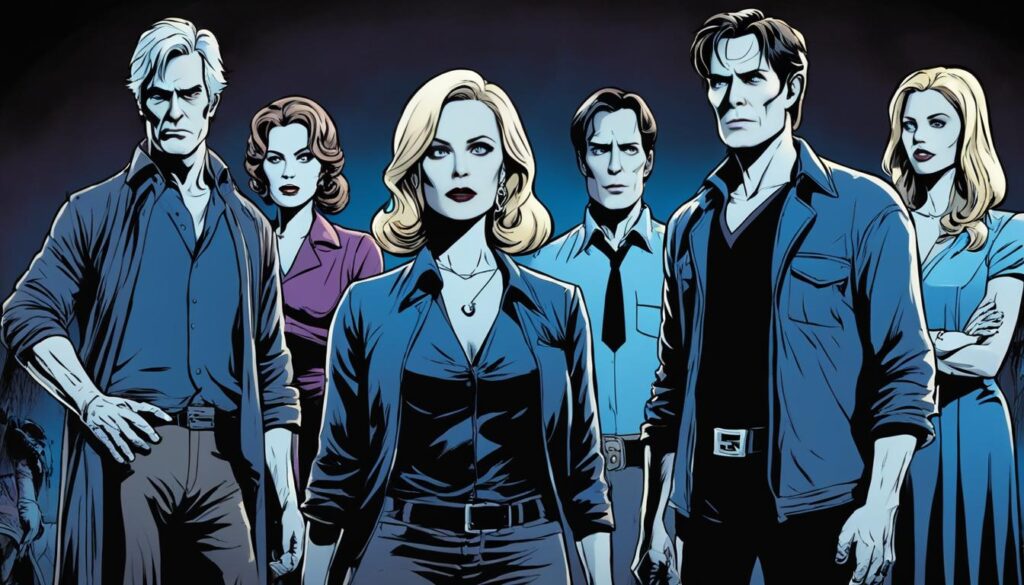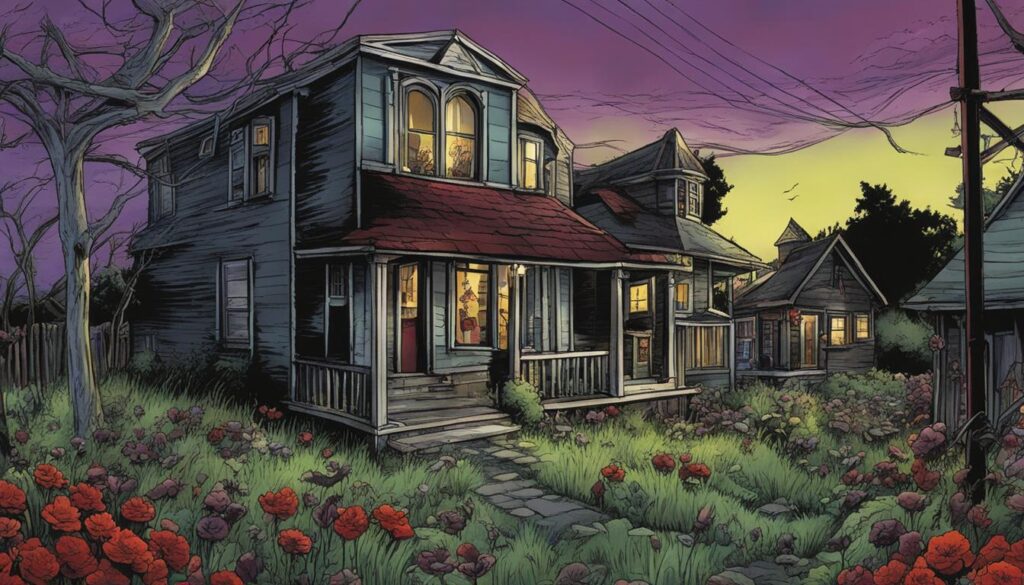Welcome to our book summary of “Living Dead in Dallas,” the thrilling second installment in the Sookie Stackhouse series by Charlaine Harris. This page is your go-to source for a comprehensive overview of the book, including the plot, characters, and overall themes present in this captivating supernatural tale.
If you’re a fan of the Sookie Stackhouse series or looking for a book summary that’s packed with all the essential information, you’ve come to the right place. In the following sections, you’ll find everything you need to know about “Living Dead in Dallas,” from the setting and atmosphere to the critical reception and impact on popular culture.
Key Takeaways
- The second installment in the Sookie Stackhouse series, “Living Dead in Dallas,” is a thrilling and supernatural journey
- The book is written by Charlaine Harris, who creates a captivating world of otherworldly beings
- The plot of the book revolves around Sookie Stackhouse, a telepath, who gets involved in mysterious and dangerous events
- Readers will be introduced to the main characters and their motivations, relationships, and conflicts that drive the story forward
- Throughout the book, Charlaine Harris tackles broader themes such as prejudice, discrimination, and the power dynamics between humans and supernatural beings
Introduction to the Sookie Stackhouse Series
The Sookie Stackhouse series is a collection of 13 novels written by Charlaine Harris. The books were first published starting in 2001 and the final installment was released in 2013. The series follows the story of Sookie Stackhouse, a waitress from Louisiana with the ability to read minds. Set in a world where supernatural creatures are known to exist, the books tell the story of her encounters with vampires, werewolves, shapeshifters, and other supernatural beings.
Charlaine Harris is an American author, born and raised in Mississippi. Her writing has been lauded for its unique blend of mystery, romance, and the supernatural. Harris’s ability to create intricate worlds filled with memorable characters has won her a dedicated fan following over the years. As an established creator of modern-day literature, Harris’s works have been adapted into several adaptations, including HBO’s hit series True Blood.
The Sookie Stackhouse Series
| # | Title | Publication Date |
|---|---|---|
| 1 | Dead Until Dark | 2001 |
| 2 | Living Dead in Dallas | 2002 |
| 3 | Club Dead | 2003 |
| 4 | Dead to the World | 2004 |
| 5 | Dead as a Doornail | 2005 |
| 6 | Definitely Dead | 2006 |
| 7 | All Together Dead | 2007 |
| 8 | From Dead to Worse | 2008 |
| 9 | Dead and Gone | 2009 |
| 10 | Dead in the Family | 2010 |
| 11 | Dead Reckoning | 2011 |
| 12 | Deadlocked | 2012 |
| 13 | Dead Ever After | 2013 |
“The Sookie Stackhouse series is a must-read for fans of the supernatural genre. Charlaine Harris has crafted a world filled with mystery, intrigue, and unforgettable characters. Her unique blend of romance and the supernatural draws readers in and keeps them hooked until the very last page.” – New York Times Bestselling Author, Stephenie Meyer
Overview of Living Dead in Dallas
“Living Dead in Dallas” is the second installment in the Sookie Stackhouse series, written by Charlaine Harris. The book continues the thrilling supernatural journey of the protagonist, Sookie Stackhouse, and her interactions with the supernatural world.
The plot revolves around Sookie’s employment at Fangtasia, a vampire bar in Dallas. She is hired by Eric Northman, the leader of the vampire community. However, Sookie soon finds herself embroiled in a dangerous situation when a fellow worker is murdered, and she becomes the prime suspect. In the midst of this turmoil, Sookie also has to confront her tumultuous relationships, with both vampires and humans.
The book explores themes of identity, belonging, and power. The conflict between humans and vampires is a prominent motif, with the latter group being represented as oppressed and marginalized. Harris also delves into the complexities of human-vampire relationships and the consequences of these dynamics.
The characters in “Living Dead in Dallas” are well-developed and nuanced, including Sookie’s vampire love interest, Bill Compton, and her shape-shifting boss, Sam Merlotte. The antagonists are equally compelling, with Harris exploring the motivations and histories of the book’s villains.
The pacing of the book is brisk, with enough action and suspense to keep readers engaged. The writing style is accessible yet nuanced, and the book’s setting in Dallas is well-described, enhancing the overall atmosphere of the work.
In conclusion, “Living Dead in Dallas” is an engaging and thought-provoking read, building on the strengths of the first book. It combines elements of the supernatural, mystery, and romance genres to create a one-of-a-kind reading experience.
Setting and Atmosphere in Living Dead in Dallas
In “Living Dead in Dallas,” Charlaine Harris masterfully creates a vivid setting and atmosphere that perfectly complement the supernatural elements of the narrative. The book takes place in Dallas, Texas, and its surrounding areas, as Sookie Stackhouse and her vampire love interest, Bill Compton, travel to the city for work.
The city of Dallas is one of the main locations in the book, and Harris paints a detailed picture of the bustling metropolitan area. The author includes references to popular landmarks and locations, such as the Dallas Museum of Art, and other cities and states, like Oklahoma and Arkansas, are also briefly mentioned.
The overall ambiance of the book is eerie and mysterious, perfectly capturing the supernatural elements of the story. From the very beginning, the book sets a dark tone that permeates throughout, with descriptions of creepy cemeteries and the looming presence of supernatural forces.
“The silence was heavy with that unreal quality, and the trees along the roadside were looming shapes that must conceal all sorts of things.”
Harris expertly utilizes the setting and atmosphere to enhance the book’s supernatural elements, making for a thrilling and chilling reading experience.
Main Characters in Living Dead in Dallas
“Living Dead in Dallas” features a diverse cast of characters with varying backgrounds and motivations. Charlaine Harris expertly weaves these characters together to create a compelling narrative. Here are some of the main characters:
| Name | Role | Description |
|---|---|---|
| Sookie Stackhouse | Protagonist | A telepathic waitress who finds herself embroiled in supernatural events. |
| Eric Northman | Antagonist/Protagonist | A powerful vampire who manipulates Sookie for his own gain but later becomes her ally. |
| Bill Compton | Protagonist | A vampire and Sookie’s love interest. |
| Jason Stackhouse | Supporting Character | Sookie’s brother, who dabbles in the world of supernatural creatures. |
| Pam | Supporting Character | Eric Northman’s loyal assistant and friend. |
In addition to these characters, there are many other compelling personalities that contribute to the richness and depth of the story. Harris masterfully develops each character’s personality and brings them to life in a way that feels authentic and believable.
“‘Living Dead in Dallas’ is a character-driven story that takes readers on an emotional journey through the eyes of its diverse cast. Each character is unique and complex, with their own motivations and desires. Harris masterfully balances their personalities and storylines to create a captivating narrative,” says one review of the book.

Plot Summary of Living Dead in Dallas
In the novel “Living Dead in Dallas,” Sookie Stackhouse, the telepathic protagonist, finds herself in the center of yet another supernatural mystery. Sookie’s boss, Sam Merlotte, asks her to use her telepathic powers and work undercover at a vampire bar named Fangtasia to investigate the disappearance of a fellow barmaid. During her investigation, Sookie discovers the barmaid’s dead body and finds herself in the middle of a larger, more complex investigation that includes a powerful sorceress, a secret sex club, and a society of vampires vying for power.
Sookie’s boyfriend, vampire Bill Compton, is also involved in the investigation as part of his job as an investigator for the vampire queen, Sophie-Anne Leclerq. Together, Sookie and Bill uncover a plot to sell vampire blood on the black market, leading to a dangerous confrontation with a group of violent anti-vampire activists. In the midst of all this chaos, Sookie also has to deal with her strained relationships with her brother, Jason, and her friend Tara Thornton.
The novel climaxes with a dramatic showdown between Sookie and the sorceress, and Sookie has to use all of her telepathic and physical abilities to come out victorious. In the aftermath, Sookie realizes that her life can never be normal as long as she is involved with the supernatural world, but she accepts her fate with courage and determination.
Themes and Symbolism in Living Dead in Dallas
One of the prominent themes in “Living Dead in Dallas” is the prejudice and discrimination faced by supernatural beings. The book presents a world where vampires, werewolves, and shape-shifters coexist with humans and highlights the prejudices they encounter. The vampire-human relationship, in particular, is a reflection of the racial prejudice that continues to exist in society. Through the character of Sookie Stackhouse, Charlaine Harris explores the complexities of discrimination, raising questions about the nature of tolerance and acceptance.
The symbolism in the book is also worth noting. A prevalent symbol is the Dallas vampire nest, which represents a corrupt system that exploits its vulnerable members. The nest serves as a metaphor for a hierarchical society, where those in power manipulate and harm those beneath them for their personal gain. Another symbolic element is the telepathy possessed by Sookie. Her unique ability to read minds symbolizes the difficulty of communication and understanding between different groups, whether they are supernatural or human.
Overall, the themes and symbolism present in “Living Dead in Dallas” contribute to its rich and thought-provoking narrative. Through her use of allegory and metaphor, Charlaine Harris invites readers to explore the complexities of societal issues and encourages them to search for deeper meanings beneath the surface.
Writing Style and Pacing in Living Dead in Dallas
Charlaine Harris is known for her engaging writing style, which effortlessly draws readers into the world of Sookie Stackhouse. In “Living Dead in Dallas,” Harris employs vivid language, creating descriptive scenes that transport readers into the story’s southern gothic world. The author’s dialogue is also well-crafted, with each character having a distinct voice, making them easy to distinguish from one another.
The novel’s pacing is relatively brisk, with each chapter ending on a cliffhanger that propels the story forward. Harris employs a variety of techniques, such as foreshadowing and unexpected twists, to keep the reader engaged throughout. The pacing is particularly effective during the novel’s more action-packed sequences, creating a sense of urgency and suspense, which adds to the overall reading experience.
The combination of Harris’s writing style and pacing in “Living Dead in Dallas” creates a compelling narrative that keeps readers hooked until the very end.
Critical Reception of Living Dead in Dallas
Since its publication in 2002, “Living Dead in Dallas” has received various critical reviews from readers and literary critics alike. The book has been praised for its fast-paced action, supernatural themes, and engaging characters. Readers have lauded Charlaine Harris for her vivid imagination and her ability to create a world that blends elements of horror, fantasy, and romance seamlessly.
Several reviews highlight the book’s intriguing plot and the tension that builds throughout the story. According to Publishers Weekly, “Harris delivers another engaging mystery peppered with sharp social commentary.”, which suggests that the author tackles relevant societal issues while keeping the story entertaining. The Chicago Tribune adds, “Harris does an admirable job of creating a heroine who’s not only interesting but completely believable in a world of the strange and the different.”, which emphasizes the strength of the book’s protagonist, Sookie Stackhouse.

However, not all reviews of “Living Dead in Dallas” have been positive. Some critics have criticized the book’s writing style, calling it simplistic or formulaic. The New York Times highlights that “Harris writes crisp, suburban prose that boldly announces its modest ambitions”, which can suggest that the book lacks artistic depth. Additionally, some reviews noted that the book’s pacing can be slow at times, making it challenging to maintain interest throughout the entire story.
Despite some negative reviews of “Living Dead in Dallas”, the book’s popularity and enduring appeal within the genre and popular culture cannot be denied. The novel has been translated into several languages and has sold millions of copies worldwide, spawning several adaptations and spin-offs in film and television.
Comparison to Other Books in the Sookie Stackhouse Series
Now that we’ve explored the key elements of “Living Dead in Dallas,” let’s compare it to the other books in the Sookie Stackhouse series. Charlaine Harris created a compelling universe where supernatural beings exist alongside humans, and it’s fascinating to see how the story develops over the course of the series.
When compared to the first book in the series, “Dead Until Dark,” “Living Dead in Dallas” proves to be a more intricate and complex installment. The narrative explores themes such as loyalty, betrayal, and trust and features a more substantial cast of characters.
As the series progresses, we see the stakes get higher, and the supernatural world becomes more dangerous. “Living Dead in Dallas” sets the foundation for these overarching themes and sets the stage for what’s to come. When compared to the later books in the series, such as “Dead and Gone” and “Dead in the Family,” “Living Dead in Dallas” proves to be a pivotal moment in the broader narrative arc.
Overall, “Living Dead in Dallas” sets itself apart from the other books in the series through its gripping plot, complex characters, and distinct atmosphere. It’s a standout installment that showcases Harris’s prowess as a storyteller and sets the stage for the supernatural drama that unfolds throughout the rest of the series.
Impact and Influence of Living Dead in Dallas
“Living Dead in Dallas” by Charlaine Harris has had a significant impact on both the literary world and popular culture. As the second installment in the Sookie Stackhouse series, this book reinforced Harris’s position as a leading author in the supernatural genre.
The book’s influence can be seen in the numerous adaptations that have been created from it. The most notable adaptation is the hit HBO series “True Blood,” which premiered in 2008 and ran for seven seasons. The show was a critical and commercial success, solidifying the book’s place in pop culture history.
Additionally, “Living Dead in Dallas” helped to popularize the concept of supernatural creatures coexisting with humans, paving the way for other popular series in the genre such as “Twilight” and “The Vampire Diaries.”
The lasting legacy of “Living Dead in Dallas” is a testament to the impact and influence that a single book can have on the literary world and popular culture. It continues to captivate readers and inspire new works, cementing its place in the pantheon of great supernatural fiction.
Adaptations and Spin-offs of Living Dead in Dallas
“Living Dead in Dallas” has inspired several adaptations and spin-offs, which attest to the book’s enduring popularity and influence.
Television Adaptation: True Blood
One of the most notable adaptations is the HBO series “True Blood,” which was based on the Sookie Stackhouse series. The show premiered in 2008 and ran for seven seasons, attracting a massive fan base with its captivating storytelling, complex characters, and supernatural thrills.
While “True Blood” encompasses elements from several books in the series, “Living Dead in Dallas” played a significant role in the second season’s plot, where it was adapted into several episodes of the show.
Graphic Novel Adaptation
“Living Dead in Dallas” has also been adapted into a graphic novel format, providing readers with a fresh visual perspective on the story. The graphic novel follows the book’s plot, depicting the supernatural adventures of Sookie Stackhouse and her allies.
Related Works Within the Sookie Stackhouse Series
The success of the Sookie Stackhouse series has inspired several related works, including short story collections and novels that delve deeper into the world and characters created by Charlaine Harris. Some of the related works inspired by “Living Dead in Dallas” include:
- “A Touch of Dead,” a collection of short stories featuring Sookie Stackhouse
- “Dead to the World,” the fourth book in the Sookie Stackhouse series, which continues the story from “Living Dead in Dallas”
- “Dancers in the Dark,” a novella featuring the story of the vampire dancer, Aubrey Shadows
The enduring popularity of “Living Dead in Dallas” is a testament to the captivating supernatural world created by Charlaine Harris, which continues to inspire and entertain readers and viewers worldwide.
Conclusion
In conclusion, “Living Dead in Dallas” is a captivating addition to the Sookie Stackhouse series, filled with the perfect amount of supernatural and mysterious elements to keep readers engaged and intrigued. Charlaine Harris has created a rich and complex world that is both fascinating and entertaining. The book’s well-crafted plot, engaging characters, and thematic elements make for a compelling read that is sure to leave a lasting impression.
The critical reception of “Living Dead in Dallas” has been largely positive, with many readers and literary critics praising Harris’s writing style and masterful storytelling. The book’s impact and influence within the literary world and popular culture cannot be overstated, and it has paved the way for subsequent adaptations and spin-offs.
Overall, “Living Dead in Dallas” is a must-read for fans of the Sookie Stackhouse series and anyone seeking a thrilling and immersive supernatural experience. The book’s enduring legacy is a testament to its incredible storytelling and the creative vision of its author, Charlaine Harris.



